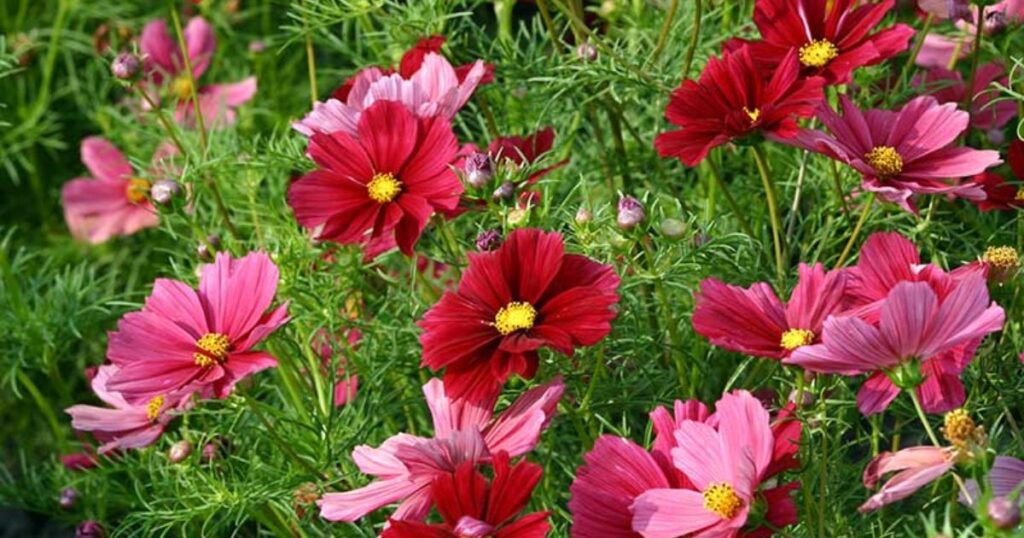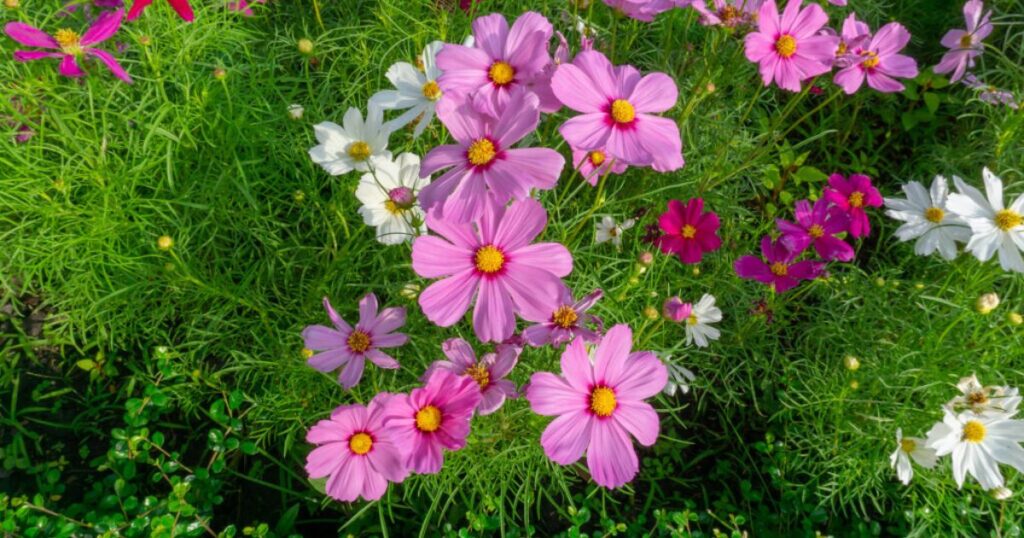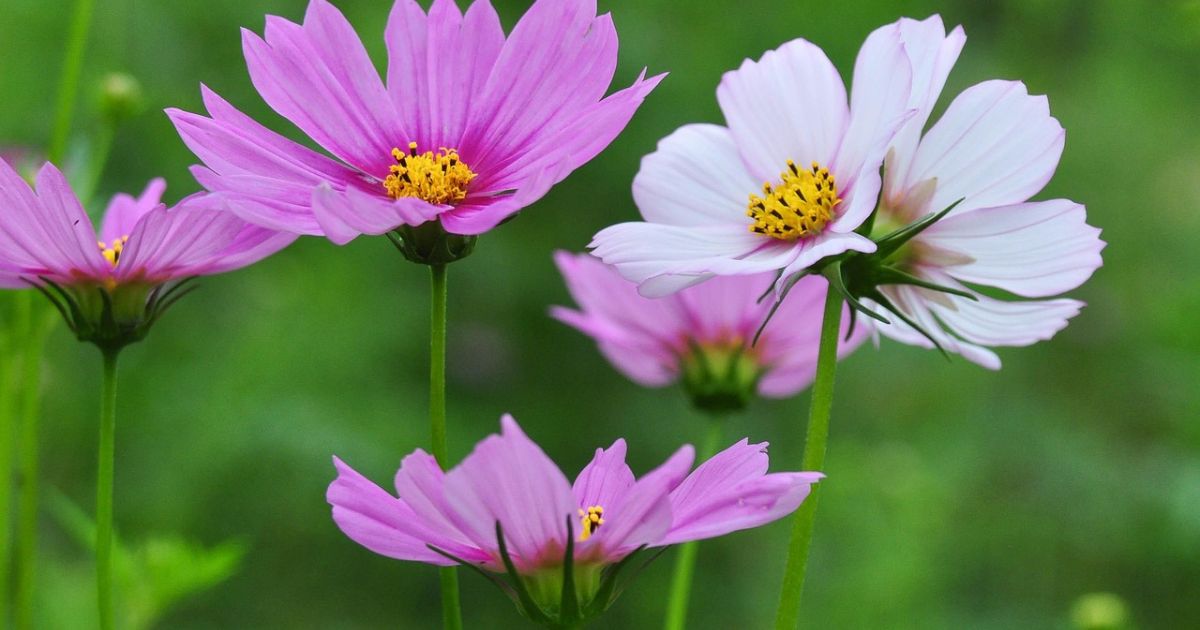Cosmos flowers are a gardener’s delight, bringing effortless charm and vibrant colour to any garden. Known for their daisy-like blooms and delicate, feathery foliage, these flowers thrive with minimal care, making them perfect for both beginners and seasoned gardeners. Blooming abundantly from summer to fall, cosmos add a cheerful splash of pinks, whites, oranges, and purples, attracting butterflies and pollinators along the way.
Their adaptability allows them to flourish in garden beds, borders, and even containers, providing versatile options for every space. Whether you’re looking to create a lively cottage garden or a simple, low-maintenance flower display, cosmos flowers offer bright, easy-to-grow beauty that brings life, colour, and joy to any outdoor setting.
The History and Origins of Cosmos
Cosmos flowers have a rich history that traces back to their origins in the Americas. The name “cosmos” comes from the Greek word kosmos, meaning “harmony” or “order,” a fitting description for their symmetrical, star-like blooms. These flowers were first documented by Spanish explorers in the 16th century, who encountered them in Mexico and brought them to Europe. By the 18th century, cosmos had spread across the globe, captivating gardeners with their resilience and cosmo flower beauty. The two most popular species, Cosmos bipinnatus and Cosmos sulphureus, are the dominant species in modern gardens.
Cosmos bipinnatus is known for its soft pinks, whites, and purples, while Cosmos sulphureus boasts fiery yellows, oranges, and reds. Both species thrive in warm, sunny climates, making them perfect for a wide range of environments. Over time, horticulturists have developed numerous cultivars, offering gardeners an array of sizes, colours, and forms to choose cosmos flowrs cosmos glower from. Cosmos also hold cultural significance in their native regions. In Mexico, they’re associated with the Day of the Dead, where their bright colours symbolise the celebration of life. Their global popularity has only grown, thanks to their ability to thrive in diverse climates and their appeal to both humans and cosmos flowers planting pollinators.
Why Choose Cosmos for Your Garden?
 Cosmos flowers are a perfect choice for gardeners seeking beauty with ease. These charming blooms thrive in almost any soil, require minimal care, and reward you with vibrant colours from summer to fall. Their feathery foliage and delicate petals add a graceful, airy touch that brightens borders, beds, and wildflower gardens. Cosmos are also pollinator-friendly, attracting butterflies, bees, and beneficial insects that enhance your garden’s colors of cosmos flowers ecosystem.
Cosmos flowers are a perfect choice for gardeners seeking beauty with ease. These charming blooms thrive in almost any soil, require minimal care, and reward you with vibrant colours from summer to fall. Their feathery foliage and delicate petals add a graceful, airy touch that brightens borders, beds, and wildflower gardens. Cosmos are also pollinator-friendly, attracting butterflies, bees, and beneficial insects that enhance your garden’s colors of cosmos flowers ecosystem.
With their tall, swaying stems, they create a stunning backdrop and make excellent cut flowers for fresh arrangements. Whether you’re a beginner or an experienced gardener, cosmos offer a low-maintenance, high-impact solution. Choose cosmos, and enjoy continuous colour, effortless growth, and a garden alive with movement and pictures of cosmos flowers life.
Low Maintenance
Low maintenance refers to products, plants, or lifestyles designed to require minimal effort, time, and resources for upkeep. Whether it’s a plant that thrives with little watering, a home appliance that cleans itself, or a wardrobe that mixes and matches effortlessly, low-maintenance options prioritise convenience without sacrificing quality or style. Ideal for busy individuals, small spaces, or those seeking stress-free solutions, low-maintenance choices reduce daily chores, save time, and provide lasting satisfaction.
Embracing low maintenance allows more focus on enjoyment, creativity, and personal priorities, making life simpler, efficient, and more are cosmos flowers perennials cosmo the flower enjoyable.
Long Blooming Season
A long blooming season ensures that your garden stays vibrant and full of life for months on end. Plants with extended flowering periods provide continuous colour, attracting pollinators like bees and butterflies while enhancing the visual appeal of outdoor spaces. These resilient blooms require minimal replanting, making them perfect for both novice and experienced gardeners seeking low-maintenance beauty. By carefully selecting long-blooming flowers, you can enjoy a dynamic garden that evolves throughout the seasons, offering fresh blossoms from spring through fall. Their enduring presence creates a cheerful, lively atmosphere that brightens any yard, patio, or balcony.
Pollinator-Friendly
Cosmos are a magnet for bees, butterflies, and other pollinators. Their open, daisy-like flowers provide easy access to nectar and cosmos flowering pollen, supporting local ecosystems and promoting zinnia flower biodiversity.
Versatility
Whether you have a sprawling backyard, a small urban plot, or a few pots on a balcony, cosmos adapt beautifully. They come in various heights, from dwarf varieties (1-2 feet) to taller ones (up to 6 feet), making them suitable for borders, containers, or as a backdrop in mixed beds.
Vibrant Colors
Cosmos flowers come in a spectrum of colours, including pink, white, purple, yellow, orange, and red. Newer hybrids growing cosmos flowers even offer bi-colored or double-flowered varieties, adding a modern twist to their classic flower cosmos charm.
Popular Cosmos Varieties
 Cosmos flowers come in a wide range of varieties, each adding unique beauty and charm to the garden. Popular types include Cosmos bipinnatus, known for its tall stems and daisy-like blooms in pink, white, and crimson shades. Cosmos sulphureus offers vibrant orange and yellow flowers that thrive in hot, sunny climates. For gardeners seeking a softer look, Cosmos’ Sensation Mix’ brings large, colourful blossoms perfect for borders and cut arrangements.
Cosmos flowers come in a wide range of varieties, each adding unique beauty and charm to the garden. Popular types include Cosmos bipinnatus, known for its tall stems and daisy-like blooms in pink, white, and crimson shades. Cosmos sulphureus offers vibrant orange and yellow flowers that thrive in hot, sunny climates. For gardeners seeking a softer look, Cosmos’ Sensation Mix’ brings large, colourful blossoms perfect for borders and cut arrangements.
Chocolate Cosmos stands out with its deep maroon petals and subtle cocoa fragrance, making it a rare favourite. These versatile varieties are easy to grow, attract pollinators, and provide long-lasting colour, making cosmos an excellent choice for both beginner and experienced gardeners.
Cosmos bipinnatus Varieties
Cosmos bipinnatus, commonly known as garden cosmos, offers a stunning variety of blooms that bring vibrant colour and airy elegance to any garden. With daisy-like flowers in shades of pink, white, and deep magenta, these varieties range from compact, dwarf types perfect for containers to tall, graceful forms that sway beautifully in borders or meadows.
Known for their feathery foliage and long flowering season, cosmos bipinnatus varieties attract pollinators like bees and butterflies, adding life to your outdoor space. Easy to grow from seed and low-maintenance, these versatile plants thrive in full sun and well-drained soil, making them a favourite for both beginner and experienced gardeners seeking cheerful, effortless blooms.
Cosmos sulphureus Varieties
- Bright Lights Mix: Fiery shades of yellow, orange, and red, with semi-double flowers that pop in sunny gardens.
- Cosmic Series: Dwarf plants (12-18 inches) ideal for borders or pots, available in vibrant orange, yellow, and red.
- Ladybird: Compact and heat-tolerant, with small, bright flowers in warm tones.
Unique Hybrids
- Chocolate Cosmos (Cosmos atrosanguineus): A perennial variety with deep maroon flowers and a subtle chocolate scent. It’s less hardy but a stunning addition to temperate gardens.
- Seashells Mix: Features tubular petals that give the flowers a whimsical, seashell-like appearance.
Each variety offers unique characteristics, allowing gardeners to mix and match for a personalised display.
How to Grow Cosmos: A Step-by-Step Guide
Cosmos flowers are among the easiest and most rewarding blooms to grow, bringing vibrant colour and delicate charm to any garden. How to Grow Cosmos: A Step-by-Step Guide walks you through everything from seed to full bloom. Learn the best planting techniques, ideal soil and sunlight conditions, watering needs, and tips for encouraging long-lasting blossoms.
Whether you want them in garden beds, borders, or containers, cosmos thrive with minimal effort and attract butterflies, bees, and other pollinators. This guide also covers deadheading, supporting taller varieties, and saving seeds for the next season. Perfect for beginners and experienced gardeners alike, cosmos offer bright, cheerful flowers all summer long.
Choosing the Right Location
Cosmos love full sun, requiring at least 6-8 hours of direct sunlight daily. They tolerate a range of soil types, including sandy or rocky soils, but prefer well-draining conditions. Avoid overly fertile soils, as they can lead to excessive foliage at the expense of flowers.
Planting Cosmos Seeds
Cosmos are typically grown from seeds, which are easy to sow directly in the garden:
- When to Plant: Sow seeds after the last frost in spring, when soil temperatures reach at least 60°F (16°C). In warmer climates, fall planting is also possible.
- How to Sow: Scatter seeds lightly over prepared soil and cover with a thin layer (about ¼ inch) of soil. Space seeds 12-18 inches apart for taller varieties or 6-8 inches for dwarfs.
- Germination: Seeds germinate in 7-14 days under optimal conditions. Thin seedlings to avoid overcrowding.
Watering and Care
- Watering: Water regularly until plants are established, then reduce to occasional deep watering. Cosmos are drought-tolerant once mature.
- Fertilising: Avoid heavy fertilisation, as it can reduce blooming. A light application of balanced fertiliser (e.g., 10-10-10) at planting is sufficient.
- Deadheading: Remove faded flowers to encourage continuous blooming. If you want cosmos to self-seed, leave some spent blooms on the plant.
Pest and Disease Management
Cosmos are relatively pest-resistant but may occasionally attract aphids or spider mites. Use insecticidal soap or a strong water spray to control infestations. Fungal diseases like powdery mildew can occur in humid conditions; ensure good air circulation by spacing plants properly.
Supporting Tall Varieties
Taller cosmos (e.g., Sensation Mix) may need staking in windy areas. Use bamboo stakes or garden twine to support stems without restricting growth.
Designing with Cosmos in Your Garden
 Cosmos flowers bring effortless charm and colour to any garden design. Their delicate, daisy-like blooms and feathery foliage create a soft, romantic atmosphere while adding vibrant hues of pink, white, orange, and crimson. Ideal for cottage gardens, borders, or wildflower meadows, cosmos thrive in both formal and informal settings. Their tall, airy stems provide height and movement, making them excellent companions for shorter blooms or ornamental grasses.
Cosmos flowers bring effortless charm and colour to any garden design. Their delicate, daisy-like blooms and feathery foliage create a soft, romantic atmosphere while adding vibrant hues of pink, white, orange, and crimson. Ideal for cottage gardens, borders, or wildflower meadows, cosmos thrive in both formal and informal settings. Their tall, airy stems provide height and movement, making them excellent companions for shorter blooms or ornamental grasses.
Whether you want to design a pollinator-friendly garden, brighten a sunny corner, or fill in gaps with long-lasting seasonal colour, Cosmos adapt beautifully. With their low maintenance and prolific flowering, these versatile blooms allow you to design a garden that feels natural, dynamic, and bursting with cheerful life.
Cottage Garden Charm
Cottage Garden Charm” captures the essence of timeless, whimsical beauty in a garden setting. Overflowing with a mix of colourful flowers, climbing vines, and fragrant herbs, this style evokes a cosy, inviting atmosphere that feels both relaxed and enchanting. Soft pathways wind through abundant blooms, while rustic fences, trellises, and quaint garden ornaments add character and warmth. Ideal for gardeners seeking a natural, slightly wild look, a cottage garden celebrates biodiversity and seasonal colour. Its effortless charm combines practicality with aesthetic delight, creating a serene retreat that delights the senses and invites moments of quiet reflection and joy.
Pollinator Gardens
A pollinator garden is a vibrant, eco-friendly space designed to attract and support essential pollinators like bees, butterflies, hummingbirds, and other beneficial insects. By incorporating a variety of flowering plants, native shrubs, and nectar-rich blooms, these gardens provide critical food sources and habitats that help sustain local ecosystems. Pollinator gardens not only enhance biodiversity but also improve the health and yield of nearby fruits, vegetables, and ornamental plants. They require minimal maintenance while offering seasonal beauty, colour, and movement. Creating a pollinator garden is a rewarding way to contribute to environmental conservation and foster a thriving, balanced garden ecosystem.
Container Gardening
Container gardening is a versatile and space-saving way to grow plants, perfect for patios, balconies, and small yards. By using pots, tubs, or other containers, gardeners can cultivate flowers, herbs, vegetables, and even small fruit trees with ease. This method allows for better control of soil quality, drainage, and sunlight exposure, making it ideal for urban environments or areas with poor soil. Container gardening also offers mobility, letting you rearrange plants to suit aesthetics or seasonal needs. Whether for decorative blooms or homegrown produce, container gardening brings greenery and fresh flavours right to your doorstep.
Mixed Borders
Use cosmos as a filler in mixed borders, where their height and colour add depth. Pair with ornamental grasses, salvia, or coreopsis for a dynamic, textured look.
Cut Flower Gardens
Cosmos make excellent cut flowers, lasting up to a week in a vase. Harvest stems when flowers are just opening for the most extended vase life. Create a dedicated cutting garden with cosmos, dahlias, and snapdragons for endless bouquets.
Wildflower Meadows
For a low-maintenance, naturalistic look, sow cosmos seeds in a wildflower meadow alongside native grasses and wildflowers like black-eyed Susans or coneflowers. This creates a vibrant, low-effort landscape that attracts wildlife.
Cosmos and Their Ecological Benefits
Beyond their beauty, cosmos play a vital role in supporting ecosystems. Their nectar-rich flowers attract a wide range of pollinators, including bees, butterflies, and hummingbirds. By planting cosmos, you contribute to pollinator conservation, which is critical for food production and biodiversity.
Cosmos also support beneficial insects like ladybugs and lacewings, which prey on garden pests. Their deep roots help improve soil structure, preventing erosion and enhancing water retention. Additionally, cosmos are excellent for companion planting, as they can distract pests from vegetables like tomatoes or peppers. For eco-conscious gardeners, cosmos are a sustainable choice. They require minimal water and fertilisers, reducing your garden’s environmental footprint. Allowing them to self-seed also promotes a self-sustaining garden that returns year after year.
Cosmos in Art, Culture, and Beyond
Cosmos flowers have inspired artists, writers, and designers for centuries. Their delicate petals and vibrant colours make them a popular subject in paintings, photography, and floral arrangements. In literature, cosmos often symbolises peace, harmony, and beauty, reflecting its Greek-inspired name.
In modern times, cosmos have found their way into weddings, events, and home décor. Their long stems and bright colours make them a favourite for rustic or bohemian-style arrangements. They’re also a popular choice for edible gardens, as their petals are edible and add a colourful touch to salads or desserts.
Troubleshooting Common Cosmos Growing Issues
While cosmos are generally trouble-free, here are solutions to common challenges:
- Leggy Plants: If cosmos become tall and spindly, they may need more sunlight or less nitrogen-rich fertiliser. Pinch back young plants to encourage bushier growth.
- Poor Blooming: Over-fertilisation or overly rich soil can reduce flowering. Ensure the soil is poor to moderately fertile and avoid excess nitrogen.
- Wilting: Check for overwatering or poor drainage. Cosmos prefer well-draining soil and may rot in waterlogged conditions.
Propagating and Saving Cosmos Seeds
 Propagating and saving cosmos seeds is a simple, rewarding way to enjoy these bright, easy-to-grow flowers year after year. After the blooms fade, allow the flowers to dry on the plant, then gently collect the mature seeds. Cosmos seeds are long, slender, and easy to handle, making them ideal for home gardeners. Store them in a cool, dry place in paper envelopes or airtight containers to maintain viability for the next planting season.
Propagating and saving cosmos seeds is a simple, rewarding way to enjoy these bright, easy-to-grow flowers year after year. After the blooms fade, allow the flowers to dry on the plant, then gently collect the mature seeds. Cosmos seeds are long, slender, and easy to handle, making them ideal for home gardeners. Store them in a cool, dry place in paper envelopes or airtight containers to maintain viability for the next planting season.
Sowing saved seeds in spring ensures vibrant, colourful blooms throughout summer and fall. By propagating cosmos from seeds, gardeners can preserve favourite varieties, save money, and expand their garden with minimal effort, while supporting a sustainable, self-renewing planting cycle.
Cosmos in Different Climates
Cosmos are adaptable to various climates but perform best in USDA zones 2-11 as annuals. In warmer regions (zones 9-11), chocolate cosmos may return as perennials. For colder climates, plant seeds indoors 4-6 weeks before the last frost to extend the growing season. In hot, humid areas, choose heat-tolerant varieties like Cosmos sulphureus and ensure good air circulation to prevent fungal issues.
Fun Facts About Cosmos
- Cosmos are named after the Greek word for “universe,” reflecting its starry appearance.
- They were introduced to Europe by Spanish priests who grew them in mission gardens.
- Cosmos flowers can attract up to 30 different species of pollinators in a single season.
- Their petals are edible and have a slightly tangy flavour, perfect for garnishing dishes.
Conclusion:
Cosmos flowers are a gift to gardeners, offering vibrant beauty, ease of care, and ecological benefits. Whether you’re looking to create a pollinator haven, a colourful border, or a low-maintenance container garden, Cosmos deliver. Their ability to thrive in diverse conditions, coupled with their long blooming season and versatility, makes them a perfect choice for beginners and experts alike. So, grab some cosmos seeds, find a sunny spot, and let these bright, easy blooms transform your garden. With minimal effort, you’ll enjoy a season filled with colour, life, and the joy of gardening.
FAQ:
What are Cosmos Flowers?
Cosmos are vibrant, daisy-like flowers known for their bright colours, delicate petals, and feathery foliage. They are popular in gardens because they bloom easily, attract pollinators, and require minimal care.
What Colours do Cosmos Flowers come in?
Cosmos flowers come in a variety of colours, including pink, white, red, orange, and purple. Some varieties also have bi-colored petals, adding extra charm to gardens.
When do Cosmos Flowers Bloom?
Cosmos bloom from early summer through fall. In most climates, they flower continuously as long as they receive full sun and regular watering.
How do I Plant Cosmos Flowers?
Cosmos can be grown from seeds or seedlings. Plant seeds directly in well-draining soil after the last frost. They prefer full sun and can thrive in poor to average soil, making them very low-maintenance.
How often should I Water Cosmos?
Water newly planted seeds or seedlings regularly to establish roots. Once established, Cosmos are drought-tolerant and need only occasional watering. Avoid overwatering, as soggy soil can harm the plant.







